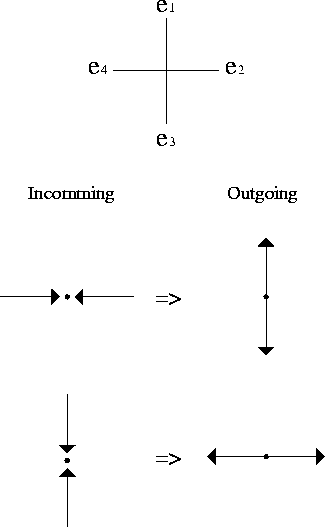The first lattice gas model was introduced by Hardy, Pomeau and de Pazzis
(HPP) [16, 17] . The particles are restricted to travel on
the links
![]() of a square
lattice, where
of a square
lattice, where
![]() , see figure 3-1.
, see figure 3-1.

Figure 3-2: The collision rules
for the HPP model. The left hand column
shows the incoming configurations and the right hand column shows the
corresponding outgoing configurations after the collision.
Figure 3-1: The square grid used in the HPP model.
Each particle travels at unit speed so it moves from one
lattice site to a neighbouring site in each time step. An exclusion rule
is applied so that only one particle is allowed to travel in each
direction along a link. This means that a maximum of four particles can
arrive at any site at any time step. When particles arrive at a site
they collide according to the collision rules shown in figure
3-2: at any site where there is an incoming configuration
shown in the left hand column the particles collide to give the outgoing
configuration shown in the right hand column.
If the incoming configuration is not shown on the left-hand side
of figure 3-2 then the particles continue travelling in a straight
line.
It can easily be
seen from these collision rules that both the number of particles and
the momentum at each site is conserved and thus the total particle
number and total momentum are also conserved. It has been shown
[8] that viscous dissipation is anisotropic due to the underlying
square grid and so
it is necessary to use a different underlying grid in any
simulation of fluid flow.